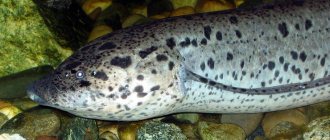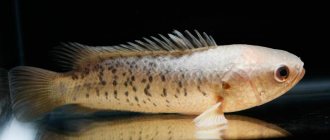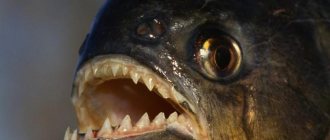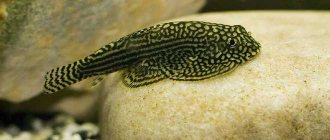5
(7)
Many aquarists prefer to keep cichlids. They are attractive due to their bright colors, large size and playful behavior. Labidochromis is the most popular representative of this species. This colorful and peaceful fish is a favorite of both experienced breeders and beginners.
Labidochromis kimpuma ed
29.01.2019
Recently, not many cichlids have appeared on the domestic market of African cichlids that would immediately attract such close attention.
It would seem that our aquariums are filled with such a variety of shapes and colors that it is not so easy to surprise us. But a few years ago, the Malawian cichlid Labidochromis spec. was brought to Russia for the first time. “Kimpuma red” (according to the Russian transcription of Labidochromis “Kimpuma Red”). This interesting fish, slightly different in color, immediately gained popularity and today is perhaps one of the most sought-after Malawian cichlids. In their behavior, Kimpum Red are typical representatives of the Mbuna group, a little tougher in character than Labidochromis caeruleus “Yellow” (Labidochromis “Yellow”), which generally get along with any comparable cichlids. It is recommended to keep them with peaceful and proportionate Malawian cichlids in aquariums of 200 liters or more. In such volumes they feel quite comfortable if they are in a harem or flock consisting of 1 male and 3-4 females, provided that shelter is provided in case of a showdown or during the spawning period when males are most aggressive. In nature, they grow up to 8-10 cm; in aquarium conditions with volumes of more than 400 liters, the size of Kimpum can be slightly larger, up to 9-11 cm. No special problems in maintenance and nutrition, at least in my farm according to Crimea Red, have been noticed. Here is a summary of the conditions of detention:
— Water temperature: 24-26;
— Acidity: not lower than 7.5
— Hardness: from 8 and above.
Newborn fry of Labidochrosov Kimpum Red require very little space to grow, approximately 0.5 liters per fry, and when the fry reaches a size of 2-2.5 cm, one should proceed from the calculations of 1 liter per tail. If these rules are neglected, then growth slows down and the effect of a “tight fish” may appear.
General information
Labidochromis sp. is a genus of ray-finned fish from the Cichlid family. Currently, it includes 18 described species.
They are endemic to the African Lake Malawi and belong to the Mbuna group - these are cichlids that feed mainly on algal fouling (and various invertebrates living on them) on coastal rocks. The mouthparts of fish are ideally suited for scraping lower plants: they are small in size with small elongated conical teeth curved in the opposite direction, which are shaped like tweezers. Thanks to such teeth, labidochromis can extract algae even from the smallest cavities in rocks. This is reflected in the name of the genus, which comes from the Greek word “labidos” - forceps.
Labidochromis "Perlmutt" - a species that has not yet received a scientific description
The fish are undemanding to conditions and relatively peaceful, and are also easy to breed, so they are recommended to anyone who has decided to try their hand at keeping Malawian cichlids for the first time.
Labidochromis fish. Description, features, content and price of labidochromis fish
When the size reaches approximately 4-5 cm, a jump occurs, caused by the first manifestations of spawning games, and it is already advisable to transplant Kimpum into species aquariums with shelters.
In adolescence, small skirmishes and “attacks” on each other are already noticeable, most likely caused by the fact that the fish need to stake out their place in the flock, some are destined by fate to be the successor of the family (to be a dominant male), and others take a wait-and-see attitude by procreation (subdominant males). The dominant male in a flock of adolescents becomes noticeable already in the 3rd month of life. He clearly begins to overtake other teenagers in size and begins to change color very early.
In captivity, Labidochromis "Kimpuma Red" lives 5-7 years. Fish that live in the same aquarium for a long time get used to the owner, recognize him, and sometimes take food from his hands. Get these amazing motley perches in your home and you won’t regret it.
This site was created using Okis. Create your own for FREE.
Interesting Facts
Cerulius are very tenacious. They show amazing ingenuity in matters of safety and are able to survive in the same body of water even with larger predators.
Labidochromis willingly dig up the bottom in search of food . Sometimes they are able to move not too heavy decorative elements simply by pushing them.
If labidochromis fry are kept in a pond with plants, then there is a high probability that when they grow up, they will not eat the bushes.
Cerulius are very beautiful and unpretentious fish. They are easily adaptable and do not require special conditions , so even a novice aquarist can handle them.
Labidochromis hongi
Labidochromis hongi comes from Lake Malawi and is found on the rocky screes of Hongi Island, which is why it got its name. Aquarists value the fish for its bright colors. However, remember that there is marked variability in coloration within populations. The forehead, back of the head and dorsal fin of the classic Labidochromis hongi range in color from yellow to orange. The "Kimpuna red" hongi (in the video), which is gaining popularity, has these body parts in orange and red. The fish grow up to 12 centimeters and stay in the lower and middle layers of water.
A 200-liter aquarium is enough to support a flock of one male and 4-5 females. The number of shelters on the bottom should exceed the number of fish. Do not overload the pond with decorations - leave room for swimming. Labidochromis hongi is an active fish. Aggression on the part of the male towards neighbors is possible during the spawning period. The neighbors in the aquarium are calm, peace-loving Malawian cichlids of the Mbuna group.
Comfortable parameters: water temperature 24-28°C, dH 8-20°, pH 7.5-8.5. The soil in the aquarium is sandy or fine gravel. Effective aeration and filtration are required. The lighting is bright with an intensity of 0.5 W/liter, daylight hours are 10 hours.
Diseases
Most health problems in labidochromis occur due to violation of the conditions of detention or incorrectly selected neighbors in the aquarium.
Injuries
Most fish injuries occur due to fights between males and collisions with decorative elements.
Therefore, it is important to maintain the ratio of males and females in the tank so that the gentlemen do not show excessive aggression.
When installing new decorative elements, it is important to make sure that they do not have sharp protrusions or corners that could harm the fish.
Poisoning
Heavy metal salts, chlorine and ammonia dissolved in water can cause deterioration in the health of fish and lead to poisoning. Signs of intoxication are:
- loss of coordination;
- rapid breathing;
- decreased activity.
To prevent poisoning, reserve water for replacement. thoroughly, but without detergents , or it is better to keep them in a separate container for 3-5 days before installing them in the aquarium.
Tuberculosis
Unfortunately, it is almost impossible to save a sick fish. It is placed in a separate aquarium and a solution of vitamin B6 is added to the water. The disease enters the aquarium along with infected fish.
Ichthyophthirosis, or semolina
This disease is characterized by white dots that appear abundantly on the body of the fish. Zelenka is used as a treatment.
Fin rot
The disease is characterized by the appearance of a whitish coating on the plumage of fish, and then red stains. The fins are completely destroyed over time.
Antibiotics, brilliant green and gentian violet solution are used as treatment.
Description of appearance
Labidochromis is a ray-finned cichlid. These are endemic species, whose homeland is the famous Lake Malawi, located in Africa. The fish feed on algae and small invertebrates. Their mouth is adapted for scraping vegetation from coastal rocks; the teeth are sharp and small, curved on the reverse side and resemble tweezers (hence the name “Labidos” - forceps). They manage to reach plants even in small depressions and depressions, descending to a depth of 30 meters.
The body of labidochromis, like other cichlids, is massive, slightly elongated, torpedo-shaped, flattened on both sides. Adult fish reaches 10 cm in length. The dorsal fin extends to the base of the tail and has a pointed angle at the end. The anal fin is oval in shape and decorated with orange splashes.
It is impossible to indicate a specific body color of the fish, since each subspecies has its own characteristics. The color can be monochromatic or with multi-colored spots and stripes.
In aquarium conditions, Labidochromis will live up to 10 years with proper and complete care.
Natural habitat
This is another one of the African inhabitants who moved from there to our aquariums. The fish live in the waters of Lake Malawi, which washes the shores of three African states. The rocky shores of Tanzania are especially attractive to them. Here they gather in large flocks. Labidochromis Hongi feeds mainly on small arthropods and larvae that live on algae among underwater rocks.
Maintenance and care
In their natural environment, labidochromis are accustomed to keeping in pairs or flocks of 1 male and 3-4 females. For such a number of fish you will need a container with a volume of about a hundred liters. Be sure to have a lid as fish can jump out of the water.
A suitable style for decorating an aquarium is biotope. To create it, you will need sand or crushed marble as a soil, which will give the water the necessary alkaline environment. You will also need large uneven stones to create shelters and artificial grottoes for pets. Most of the aquarium should be left free so that the fish can frolic. To decorate the aquarium, you can plant Vallisneria along the back and side walls. This is the most unpretentious plant that will saturate the environment with oxygen and become an additional feed for pets.
To create suitable conditions, you will also need a powerful filter (it is recommended to use an external one) and a compressor. Water parameters should be as follows:
- Temperature within 25-28 degrees;
- Acidity 7.4-8.4 pH;
- Hardness from 8 to 20 GH.
Regular replacement of water with fresh water is important - 25% every week.
Labidochromis are heat-loving fish, so a heater and thermometer are essential to keep your fish healthy.
As mentioned above, in the natural environment, the main diet of animals consists of algae and the invertebrates that live in them. Therefore, artificial feeding should include plant and animal feed.
A diet consisting of one type of food will lead to gastrointestinal disorders and health problems. It is recommended to give cichlids high-quality dry compositions based on spirulina and natural treats - brine shrimp and bloodworms in nutritious jelly. These foods are completely safe.
In order to maintain the bright color of cichlids, you need to include in the diet compositions that include natural carotenoids.
Fish feeding is carried out in the morning and evening. Portions should be such that the fish eat everything in a few minutes. If there is food left over, you need to remove the excess and reduce the portion next time.
Feeding
Labidochromis is an omnivorous fish whose main food is algae, mollusks, insects and plants. With its small and sharp teeth, the fish extracts food from cracks and crevices. Proper nutrition for fish should consist mainly of plant food: spirulina, spinach, lettuce, peas and other vegetables. For live food, snails and small crustaceans are suitable.
These cichlids are prohibited from feeding bloodworms and tubifex, which can cause bloating and other fatal diseases in the fish. Overfeeding of fish should also be avoided.
Return to content
Compatibility of Labidochromis with other fish
Labidochromis are peaceful fish with a calm and pliable character. Despite the fact that most cichlids are aggressive towards any neighbors, these pets may not even notice other fish in the general aquarium. The only thing that can cause hostility in labidochromis is fish with similar colors or veil fins.
Ideal neighbors will be commensurate cichlids, such as melanochromis, pseudotropheus, as well as smaller labeos and ancistrus. Synodontis and pterygoplichthys catfishes will feel great at the bottom.
Famous family
Newcomers to the aquarium hobby are sometimes perplexed as to why so many underwater creatures have the same name. Actually the answer is simple. The subfamily Pseudocrenilabrinae includes the genus Labichromis Hongi. Today it includes 18 species of fish. Therefore, it turns out that one pet store can sell several varieties. Accordingly, on the aquarium hangs a tag with the name of the genus and several more letters designating the subspecies, which few people pay attention to anymore.
Breeding
As a rule, reproduction of labidochromis in aquarium conditions occurs without human intervention. Spawning is possible even in shared aquariums, and the fish do not interfere with each other.
It is incredibly difficult to distinguish a female from a male. Typically, signs of difference appear at the time of puberty, which occurs at 7-8 months.
To provoke spawning, it is enough to slightly raise the water temperature. The male chooses a place and thoroughly cleans it, preparing it for the process. Having lured the female there, she begins to lay eggs, which the male immediately fertilizes. The female then collects the eggs in her mouth and carries them for about three weeks, allowing the eggs to develop. Since she lays about 25 eggs at a time, this method increases the chances of survival of the fry. At this time, the female does not feed, but this is not detrimental to her.
The caviar is quite large, each grain is about 3 mm in diameter. The fry also emerge large enough to be fed dry fry formulas as starter food. To raise all the babies, it is enough to provide plenty of hiding places for them in the aquarium.
Labidochromis yellow
It’s easy to guess that the name of the species comes from the rich lemon color of the fish. The fins are transparent and have a contrasting black stripe along the body. An adult labidochromis hummingbird grows up to 10 cm in length. Does not require much space in the aquarium, is calm, reproduces well in captivity. The male Labidochromis yellow differs from the female by black stripes on the anal and ventral fins. In females they are yellow.
Hongi
This is a rare species, but in recent years it has increasingly appeared in aquariums. The fish got its name from the small town where it was first discovered.
The fish have different colors, depending on their gender. Males have a blue or light blue body color, with an orange frontal area and dorsal fin. Juveniles and females are distinguished by their brown color. An adult fish reaches 14 cm in length.
Kimpuma ed.
A color morph of the previous species, bred through selection. In this case, the color of its nape and fin can be fiery orange and even red. Perhaps this is their only difference.
Mbamba Bay
The fish is colored blue with characteristic dark blue wide stripes across the body. The fins are black, with a yellowish edging on the back and tail. They grow no more than 10 cm. They love currents and clean water.
Chizumulu
A dwarf cichlid, 7 to 9 cm long. Males are white or bluish with dark vertical stripes from the head to the middle of the body, and females are cream or beige.
Nkata Bay
It also got its name from the locality in which it was first caught. The color of the fish is white, with a pearlescent tint. The fins are transparent, slightly blue; all, except the caudal one, have a wide black stripe at the edges. In aquarium conditions they reach 8 cm in length.
Textile
It got its name due to its unusual color. The body of the blue fish is dotted with brown spots that form longitudinal stripes from head to tail. The pelvic and anal fins are blue, with characteristic black stripes. These fish are also small in size and grow up to 7 cm.
Blue
Males of this species have a rich blue body color with pronounced purple or blue stripes across the body. The color of females is lighter. Maximum body length 12 cm.
How helpful was the article?
Average rating 5 / 5. Votes count: 3
We are sorry that this post was not helpful to you!
Reproduction
Labidochromis Hongi Shveden reaches sexual maturity by about a year. The photo (see above) allows you to evaluate how bright its color becomes during this period. Males especially change. If you are planning to breed, it would not hurt to familiarize yourself with the secrets of experienced aquarists.
Spawning is stimulated by increasing the water temperature by 1-2 degrees. Before spawning, the male prepares a spawning site. Usually it is a large stone. During the spawning process, the female lays a relatively small number of eggs, about 50 pieces. After they are fertilized by the male, she will collect them in her mouth. For 25 days, she will serve as a living incubator, protecting her offspring. After this, the fry begin to leave their shelter, feed and swim on their own. During the first days they catch live dust and can feed on brine shrimp.











